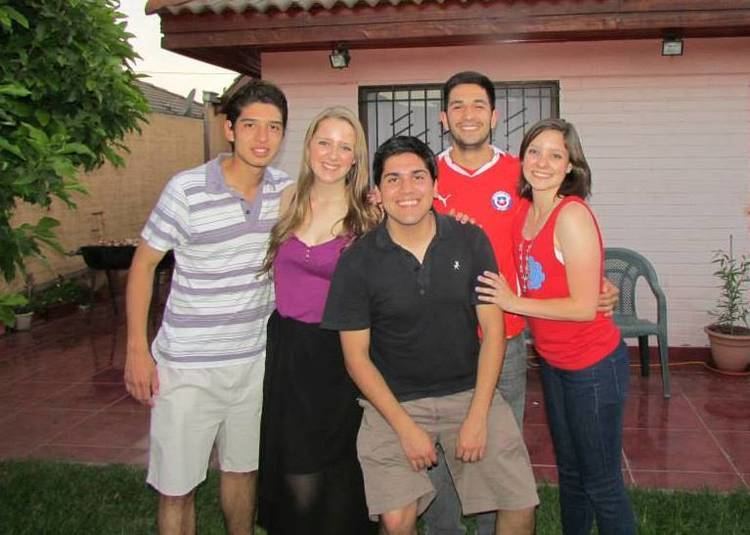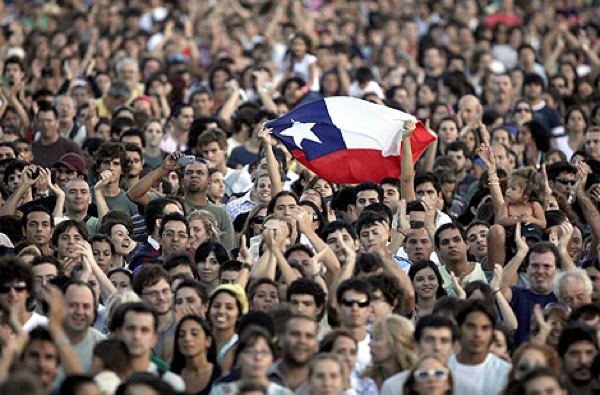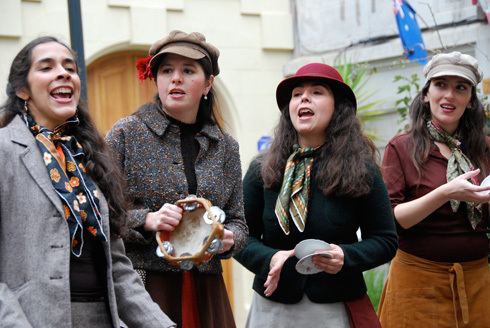Argentina 429,708 Sweden 42,396 Australia 33,626 | United States 113,934 Canada 37,577 Brazil 28,371 | |
 | ||
Chileans what is your opinion of chilean spanish
Chileans (Spanish: Chilenos) are natives of and long-term immigrants to Chile. Chileans are mainly the admixture of Spanish descent with indigenous peoples, with small, albeit important, degrees of 19th- and 20th-century European immigrant ancestry. There is a strong correlation between Chilean people's ancestry or ethnicity and socioeconomic situation: a marked continuum exist between the lower classes of high Amerindian ancestry and the upper classes of mainly European ancestry. Indigenous inheritance (cultural or genetic) is most visible in rural areas and in aspects of culture such as Chilean cuisine and Chilean Spanish. Although post-independence immigrants never made up more than 2% of the population, there are now hundreds of thousands of Chileans with German, British, French, Croatian, Italian or Palestinian ancestry.
Contents
- Chileans what is your opinion of chilean spanish
- Ethnic structure
- Ancestries and genetics
- Self perceptions
- Spaniards mestizos and Indians
- European immigrants
- Indigenous Chileans
- Culture
- Emigration of Chileans
- References
Though the majority of Chileans reside in Chile, significant communities have been established in multiple countries, most noticeably Argentina and the United States. Other large Chilean communities are in Australia, Canada and Sweden. Although small in number, Chilean people also make up a substantial part of the permanent population of Antarctica and the Falkland Islands (see: Chileans in the Falkland Islands).

Ethnic structure

As in other Latin American countries, in Chile, from the onset of Spanish colonization and settlement, miscegenation or mestizaje was the norm rather than the exception. Today, ethnic and racial self-identities are highly fluid and can differ between persons of the same family, including siblings of the same parentage. It is dictated not only by strict physical appearance, nor more loosely by ancestry (actual or presumed), but by cultural patterns, social class, wealth and access, language, and prevailing biases of the era. These very factors, indeed, lend to the significantly varying ethnic structure figures from one source to the next. Additionally, those various figures refer to different, even if often overlapping, concepts: including racial vs ethnic categories, self-identity vs genetic findings, as well as culturally assigned categories. These concepts should not be confused, and the figures represented in one source might not be corresponding to figures of concepts from another source.

Thus, for instance, UNAM professor of Latin American studies, Francisco Lizcano, in his social research estimates that a predominant 52.7% of the Chilean population can be classified as ethnically European, with an estimated 44% as Mestizo. Other social studies put the total amount of Whites at over 60 percent. Some publications, such as the CIA World Factbook, state that the entire population consist of a combined 95.4% of "Whites and White-Amerindians", and 4.6% of Amerindians. These figures are based on a national census held in 2002, which classified the population as indigenous and non-indigenous, rather than as White or Mestizo.
Ancestries and genetics

A public health book from the University of Chile states that 30% of the population is of Caucasian origin; Mestizos are estimated to amount a total of 65%, while Native Americans (or Amerindians) comprise the remaining 5%.
An autosomal DNA study from 2014 found out Chile to be 44.34% (± 3.9%) Native American, 51.85% (± 5.44%) European and 3.81% (± 0.45%) African. In regard to average admixture by social class and regions, a genetic study indicated that the composition of ancestries of the average middle class person of Chile's capital Santiago to be 70% European and 30% Native American. The low class average was 41% European and 59% Amerindian, whilst the results for the upper class were 91% European and 9% Native American. Other genetic studies have found that in Santiago, about 84% of mitochondrial DNA is of Amerindian origin, while the European contribution in the Y chromosome is about 70%, and between 6% to 15% Native American, depending on the area of the city. Other cities with a historically higher proportion of European input in the middle-class people, such as Concepción, exhibited 75% European and 25% Native American ancestries, while in Valparaíso, the composition found was 77% European and 23% Native American. While in the north of the country, studies revealed that most people had a higher Native American component.
Self-perceptions
Regardless of genetic considerations, many Chileans, if asked, would self-identify as white. The 2011 Latinobarómetro survey asked respondents in Chile what race they considered themselves to belong to. Most answered "white" (59%), while 25% said "mestizo" and 8% self-classified as "indigenous". A 2002 national poll revealed that a majority of Chileans believed they possessed some (43.4%) or much (8.3%) "indigenous blood", while 40.3% responded that they had none.
Spaniards, mestizos and Indians
For at least 12,000 years, numerous indigenous peoples settled in central and southern Chile. The predominant Mapuche inhabited these areas up until the Spanish conquest. During the colonial period, troops were sent out to the Americas by the Spanish Crown in order to protect distant colonies. Spanish folk immigrated from all regions of Spain, particularly Andalusia, Extremadura, Basque Country, Asturias, Navarra and Castile. Of the Spanish, many immigrants ultimately settled in Chile after the Mapuche resistance to the conquest.
The government of Agustín de Jáuregui, which ruled around 1777–1778, ordered the first general population census. The census confirmed a total of 259,646 inhabitants at the time, with 73.5% classified as Caucasian (white), 7.9% as Mestizo, 8.6% as Indian, and 9.8% as African (black). In 1784, Francisco Hurtado, governor of the province of Chiloé, conducted a population census in Chiloe that totaled 26,703 inhabitants, of which about 64.4% was classified as españoles ("Spaniards", Caucasian and Mestizo people) and 33.5% considered indios ("Indians").
In 1812, the Diocese of Concepción conducted a census to the south of the Maule river; however, this did not include the indigenous population — at that time estimated at 8,000 people — nor the inhabitants of the province of Chiloé. It put the total population at 210,567, of which 86.1% was native Spaniards and 10% were Indian, with a remaining 3.7% of Africans, mulattos, and mestizo descent. Other estimates in the late 17th century indicate that the population reached a maximum total of 152,000, consisting of 72% whites and mestizos, 18% Indians, and 10% blacks and mulattos.
For many years, Spanish-descent settlers and religious orders imported African slaves to the country, which in the early 19th century constituted 1.5% of the national population. Despite this, the Afro-Chilean population was negligible, reaching a height of only 2,500 — or 0.1% of the total population — during the colonial period.
In the 18th century, many Spanish civilians (mainly of Basque origin) entered the country, in particular attracted by trade liberalization at the time enacted by the Spanish Crown. In the late 18th century, Basque descendants were estimated to comprise 27% of the total population. Most of the Basque immigrants initially partook in small businesses, though others attained higher levels of prosperity. Of those, many mixed with the Criollo aristocracy of Castilian origin, who owned much of the land. This resulted in the Castilian-Basque aristocracy, which later came to form the basis of the Chilean ruling class. The number of descendants from Basques in Chile are estimated at 10% of the population (1.7 million).
European immigrants
After Chile's independence successive waves of Spanish, Italians, Irish, French, Greeks, Germans, British, Dutch, Croats, Russians, Poles, Hungarians, Portuguese and Middle Eastern people immigrated to the country.
A substantial German immigration took place in 1848, laying the foundation for the German-Chilean community. Under a government sponsored programme aimed at colonizing the southern region, the Germans (including German-speaking Swiss, Silesians, Alsatians and Austrians), colonized the south and have since influenced the cultural and racial composition of the southern provinces of Chile. It is estimated that 150,000 to 200,000 Chileans could have German ancestors.
About 700,000 Chileans, or 5% of Chile's population, has Arab ancestry. Of these 500,000 are Palestinian descendants.
Other historically significant immigrant groups include: Croatians, whose numbers today are estimated at 380,000 persons, about 2.4% of the population. 4.6% of the Chilean population has some Croatian ancestry. Over 700,000 Chileans, 4.5% of Chile's population, has British (English, Scottish and Welsh) origin.
Between 90,000 and 120,000 Chileans are of Greek origin. Most live either in the Santiago or Antofagasta areas. Chile is one of the 5 countries with the most Greeks in the world. The number of Swiss is about 90,000. About 5% of the Chilean population has some French ancestry. 600,000 to 800,000 are Italians. Other European groups are found in smaller numbers.
The European immigrants have transformed the country culturally, economically and politically. European emigration in Chile and to a lesser extent, the arrival from the Middle East during the second half of the 19th and 20th centuries, was the most important in Latin America second to that which occurred in the Atlantic Coast of the Southern Cone (i.e., Argentina and southern Brazil).
These European ethnic groups have intermarried thereby diluting the distinct cultures, descent and identities of the home countries and fusing them among each other. There has also been intermarriage with the original Basque-Castilian aristocracy of the colonial period. These intermixed cultures form the society and culture of the Chilean middle and upper classes. The European have still preserved elements of themselves, therefore they enjoy the original European cultural practices such as the British afternoon tea and biscuits, French casseroles and coffee, German cakes and sausage, and Italian pasta and mineral waters. The cultural influences can also be seen in the architecture of the cities. The Chilean folk culture is not embraced as it is an offshoot of the culture of the Spaniards who settled the country in the colonial period.
Indigenous Chileans
With the independence of Chile in the 1810s, Mapuche began to be seen as Chileans by other Chileans, contrasting with previous perceptions of them as a separate people or nation.
Although indigenous peoples like Mapuche and Aymaras are in some situations contrasted against Chilean people the two demonyms are not mutually exclusive and are rather often used combined. For example, "a Chilean Aymara" can be used to contrast with Aymaras living in Bolivia or Peru.
The 1907 census reported 101,118 Indians, or 3.1% of the total country population. Only those that practiced their native culture or spoke their native language were considered, irrespective of their "racial purity."
At the 2002 census, people that declared themselves as indigenous amounted to 4.6% of the population (692,192 people); of these, 87.3% declared themselves Mapuche. as with Chileans of other backgrounds most Mapuche show varying degrees of mixed ancestry.
Some native peoples of Chile disappeared product from acculturation and miscegenation, as is the case of peoples Picunches, Diaguitas and Chonos, whereas a large number of Selknam or Onas disappeared by the extermination carried out by settlers in Tierra del Fuego in the early 20th century. Other factors that contributed to their extinction were diseases brought by Europeans, such as smallpox.
Culture
The folk culture of Chile has mostly Spanish origins, especially the huaso culture of the central part of the country, as it arose in the colonial period due to cattle ranching. It could therefore be considered an offshoot of Spanish popular culture of the 17th an 18th centuries as are the folk cultures of the rest of Latin America and also, its direct descendants, Andalusian and Castilian folk cultures. The Andalusian forms in the huaso dress is apparent to Europeans and the music and dances show Spanish origins, even though both have been adapted and are distinct from dress, music and dance in Spain today.
The ranches called fundos, where the huasos lived and worked show strong similarity with Spanish vernacular architecture, especially in the canal roofs and the interior courtyards. The fundo is now thought of as traditional Chilean architecture and is associated with the huaso.
As well as the huaso culture of the central part of the country can be seen the German, Chilote, Croatian and Magallanic culture in the south, and the Andean culture in the north.
Chile's Nueva Canción movement in modern Chilean folk culture is adapted from the folk music of the north, not of the brass bands but of the panpipes and quenas. The traditional Chilean folk music of the huasos were also popularised, particularly the tonadas, folk songs sung with a guitar, mainly on the topics of love. Several folk groups who dress in huaso costume became famous nationwide.
The folk culture that is mainly associated with the Chilean national identity is that of the huasos as that is where the Chilean state was formed and it spread northwards and southwards in the late 19th century.
Emigration of Chileans
Emigration of Chileans has decreased during the last decade: It is estimated that 857,781 Chileans live abroad, 50.1% of those being in Argentina (the highest number), 13.3% in the United States, 8.8% in Brazil, 4.9% in Sweden, and around 2% in Australia, with the rest being scattered in smaller numbers across the globe. Other Chilean refugees settled (not ranked by order of size) in Spain, Mexico, Costa Rica, United Kingdom, Canada, France, Germany and Italy.
Many pro-Allende refugees in the 1970s fled to East Germany, including president Michelle Bachelet had also lived in Australia. While anti-Pinochet refugees formed a large expatriate community in Europe and a smaller community in North America (the US and Canada).
Over 100,000 Chileans fleeing from both regimes in the 1970s and 1980s settled in the US, a small number compared to other Latino groups. The highest number settled in Miami, Florida, but smaller enclaves are in Washington, D.C.; New York City; and California (the Los Angeles area - Beverly Hills and Long Beach; and San Francisco - San Mateo County).
Approximately 2,500 Chilean exiles fled to the UK in the early 1970s and by most recent estimates the Chilean British population is in its tens of thousands, and represents a significant proportion of the UK's Latin American community. By far the largest concentration of Chileans can be found in London with significant other communities being Birmingham, Sheffield and the Manchester–Liverpool Metropolitan area.
Historic emigration took place in the early 19th century when Chilean ranchers went to Mexico after their independence. Thousands of miners from Chile went to California, the U.S. during the 1850s California Gold Rush, as well in other gold rushes in Colorado (1870s) and the Yukon (1890s). Small numbers of Chilean miners also migrated to South Africa and Australia for the same reason.
